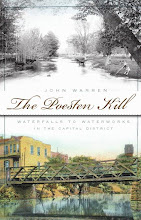 What the earliest farms on the Poesten Kill looked like is only conjecture at this point as there has been virtually no archeology aimed at the Dutch period along the kill. Two similar farms in the East Manor have been found and excavated however, but neither may reflect the kind of buildings that the English carpenter Thomas Chambers built on the Poesten Kill.
What the earliest farms on the Poesten Kill looked like is only conjecture at this point as there has been virtually no archeology aimed at the Dutch period along the kill. Two similar farms in the East Manor have been found and excavated however, but neither may reflect the kind of buildings that the English carpenter Thomas Chambers built on the Poesten Kill.
The Van Buren Site was discovered in 1973 by Art Johnson in what was once Greenbush. It was located where Indian people had also lived and was a large site that including several buildings over the years. More recently Shirley Dunn has suggested that the farm was occupied by Symon Walichsen in 1637 and later by Edward Pels and Juriaen Bestval who arrived there in 1649. A second farm found in Greenbush was that of Teunis Dirckse van Vechten who lived there from 1639 until his death in 1685. His farm suggests the kinds of activities that might have also occurred on the Poesten Kill. Van Vechten was a farmer, trader, part owner of a brewery (he grew a lot of oats), and he owned half of the yacht Het Zeepaert (The Seahorse) in 1651.
Chambers and Wemp owned the land only in the sense that they had the rights to it – these agreements would today be considered leases although they were in many ways treated as sales. It makes for a somewhat confusing history of local land transfers, especially considering that what is now Troy was the northern border of Van Renssealer’s manor, and that the English took over New Netherland in 1664.
Monday, August 10, 2009
Early Dutch Farms on The Poesten Kill
Subscribe to:
Post Comments (Atom)

No comments:
Post a Comment